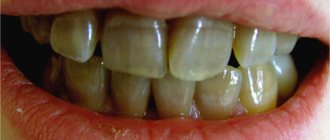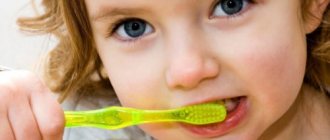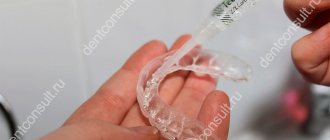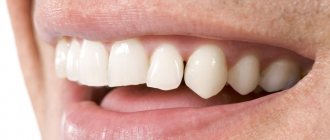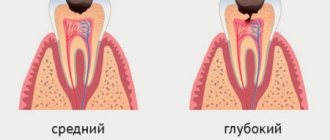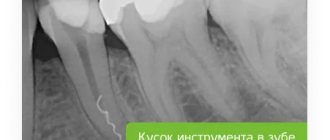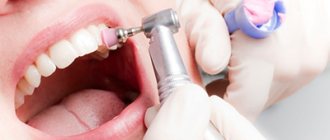In dentistry, “tetracycline teeth”
are teeth whose enamel has turned an unnatural yellowish-gray color as a result of regular use of certain antibiotics containing the component tetracycline. Special abrasive pastes or even professional teeth cleaning do not help get rid of this color, and sometimes dental teeth whitening does not help.
Why does this happen and how does tetracycline affect teeth?
Problem: “tetracycline teeth”
“Tetracycline teeth” is a characteristic of discoloration of enamel as a result of taking an antibiotic called tetracycline.
It is used to treat acute diseases caused by various bacteria. For example, pneumonia, acne, anthrax, cholera and so on. Moreover, tooth staining occurs regardless of whether the child himself took the drug, was in the mother’s stomach, or was fed breast milk. The active substances are deposited not only in the dental tissues, but also in the bone structure of the child. The most dangerous thing is that not only the outer enamel of the teeth is stained, but also the inner layer - this explains the difficulty of restoring the whiteness of the dentition.
Not the entire tooth may become stained, but only part of it, depending on which part of the tooth was formed when taking the antibiotic.
Why is this happening?
Tetracycline teeth can occur for only two reasons. Most often, the process of pathological changes in enamel occurs in the womb. This is possible if the expectant mother was prescribed tetracycline-based drugs for some reason. Dentists note that even a short course of treatment (2-3 days) can provoke this disease.
The second reason is taking medication during the eruption of permanent teeth, which usually occurs at 7-9 years of age. The teeth themselves will not become snow-white again if no measures are taken. Even in adulthood, the units will still remain dark with uneven coloration.
Expert opinion
Roman Borisovich Alekperov
orthopedic dentist
Experience: 24 years
Today there are various ways to solve the problem of tetracycline teeth. Starting from ceramic veneering to covering teeth with crowns. In any case, you can choose an option that suits your budget. Don’t waste time, get your teeth in order, and get rid of aesthetic problems and psychological discomfort that this dental pathology causes.
Tetracycline staining of teeth in adults
With age, the processes of tooth mineralization and enamel formation are minimal. All minerals and substances do not come from accumulated calcium, but from the outside, from saliva and water, and therefore tetracycline preparations for already formed adult teeth are practically harmless - if you follow the prescribed dosage.
Diagnosis of tetracycline teeth
To make a diagnosis in children, the dentist carries out a differential diagnosis of tetracycline teeth: the approximate time of darkening of the enamel (before eruption or after eruption), the cause of occurrence (pathological or congenital changes, contact with the drug, etc.) is determined. It is also important how quickly the disease progresses, the appearance of the teeth, and its location. Subjective pain with tetracycline teeth is usually absent.
Solution
Option 1: Teeth whitening. If teeth have a slight and uniform discoloration, regular whitening will be effective. For example, using ZOOM 3 technology. As a result of a simple procedure, it is possible to change the color of teeth by 8-12 shades and achieve the preservation of the result for several years. In addition, whitening is quite safe for teeth and allows you to change the shade of enamel even on sensitive teeth. Read more>
Option 2: Prosthetics with veneers. However, in most cases, teeth whitening will not achieve 100% white enamel. In case of obvious staining of teeth, the only effective method of restoring a smile is microprosthetics with veneers. Veneers are thin overlays that are fixed to the front part of the tooth. They allow you to hide all visible imperfections - dark spots, chips and cracks, as well as gaps between teeth and even minor changes in the position of the teeth. Outwardly, they resemble dental lenses and serve to create ideal dental aesthetics. Veneers are created individually and the patient will be able to choose not only the shape, but also the color of future teeth. Read more>
Causes of yellow plaque on teeth
Example of yellow teeth and whitening
A number of different factors lead to the appearance of yellow plaque on teeth. These include:
- smoking;
- daily consumption of coffee and tea;
- lack of proper oral hygiene;
- aging;
- illness;
- heredity…
Yellow plaque on teeth can also form due to improper metabolism, certain climatic conditions, or even from the use of antibiotics (some can cause tooth discoloration).
It is generally accepted that regular teeth brushing is a good and effective remedy for yellow teeth! Unfortunately, this is not entirely true! Yellow plaque can also appear in people who brush their teeth regularly!
If you are concerned about permanent yellow plaque on your teeth, we have prepared for you a number of tips and tricks to remove plaque on your teeth at home.
What is important to know about antibiotics
Doctors say the effect of antibiotics on teeth cannot be underestimated. On the one hand, they destroy harmful bacteria, stop the growth of pathogenic flora, and prevent the development of complications, in particular, infectious and inflammatory processes.
In the same dentistry, they are often prescribed after complex tooth extraction, implantation and other surgical procedures. In complex therapy for the treatment of periodontitis, gumboil, cysts, odontogenic osteomyelitis, periodontitis, periodontal disease, alveolitis. They are also prescribed as a supportive and preventative[1] measure for patients with chronic diseases. For example, diabetes mellitus and cardiovascular pathologies. For what? To avoid complications during and after dental procedures, to ensure good and rapid tissue healing.
Types of medications and possible oral side effects
Antibiotics
Antibiotics of all groups lead to dry mouth, proliferation of pathogenic microflora, increase the risk of bleeding gums, demineralization of enamel and the development of caries. Taking penicillins and macrolides can cause changes in taste sensations during meals, causing bitterness and a metallic taste in the mouth.
Drugs that include erythromycin can contribute to the development of gum hyperplasia (gum overgrowth). Medicines containing tetracycline lead not only to a change in the color of the teeth themselves, but also in the shade of the mucous membrane. Amoxicillin and clavulanic acid can also change the color of the tongue - it turns black, which makes many suspect that they have a type of glossitis called black hairy tongue.
Glucocorticoids provoke an exacerbation of chronic processes in the oral cavity that have not been cured and have been sluggish for a long time.
Expert opinion
Elena Vladimirovna Orlova
Specializations: Dentist-therapist, endodontist
Experience: 33+
“Any medications, including antibiotics, are necessary to fight various pathologies, but all of them, without exception, are potentially dangerous and can cause harm if used uncontrolled. To minimize risks, you must take any medications only in consultation with your doctor and strictly according to the instructions. After taking it, it is recommended to take medications containing probiotics, which have a positive effect on the microflora of the intestines and oral cavity.”
Other groups of drugs
In this section of the article we should talk not only about antibiotics, but also about other drugs, the abuse of which can lead to unpleasant consequences:
- non-steroidal anti-inflammatory drugs: loss of taste sensitivity, development of stomatitis,
- immunostimulants: in some cases they can activate the herpes virus in the body, leading to the development of fungal infections,
- topical antiseptics: for example, chlorhexidine and triclosan, lead not only to the destruction of bacteria that cause inflammation, but also to the neutralization of normal lactic acid flora. Abuse of these drugs can lead to worsening of the underlying disease. That is, at first there really is relief, and then the person wonders why the deterioration began. Plus, chlorhexidine also causes yellowing of the enamel,
- antimicrobial drugs, cough syrups and lozenges: many of them contain sweeteners that are detrimental to the integrity of the enamel, leading to the proliferation of harmful bacteria, demineralization of hard tissues, the development of caries,
- hormonal agents: disrupt mineral metabolism, lead to a deficiency of fluoride and calcium, which affects the strength of the enamel and reduces its resistance to bacteria. May cause bleeding gums,
- diuretics: they lead to the leaching of calcium from the body, in rare cases they can cause the development of stomatitis,
- contraceptives: weaken periodontal tissues, cause inflammation of the gums, contribute to the appearance of ulcers on them,
- products containing aspirin and painkillers: corrode enamel, provoke erosion, irritate soft tissues and cause bleeding,
- drugs for weight loss: reduce salivation, increase the risk of caries,
- Heartburn medications: Reduce calcium absorption, increase the risk of bone fractures and thin tooth enamel. In addition, scientists from McGill University conducted a study, during which it was found that frequent use of such medications can affect the survival rate of dental implants in a negative way.
“I once took iron supplements, not as directed by the doctor. They only partially solved my problem, but added new troubles: my teeth became brown, and a metallic taste appeared in my mouth. I was scared. But I was very young then, how could I smile?!! I went to the doctors. The therapist told me not to take any more medications on my own, much less antibiotics. With brown color, naturally, I had to see a dentist. We had a cleaning at the dentist. Everything seemed to have gone away, but I suffered through fear while I thought that brown enamel was forever. I got off relatively lightly, but since then I’ve never prescribed anything for myself on my own and I don’t recommend it to anyone.”
V.A., review from 32top.ru
It is important to remember that antibiotics and many medications in general have a number of other side effects that manifest themselves not only in the oral cavity, but also affect the entire body as a whole. They can cause nausea, drowsiness, headaches, confusion and disruption of the gastrointestinal tract, allergies. The more uncontrolled their use, the higher the risk of developing pathologies.
To whom are they dangerous?
On the other hand, many drugs do not have a selective effect. Many of them destroy not only harmful, but also beneficial microflora, and also lead to a number of negative consequences, which we will discuss further.
However, the most complete negative properties of such drugs can manifest themselves in the following groups of patients:
- for those who take medications without a doctor’s prescription,
- in pregnant women, young children and the elderly,
- for multiple dental problems,
- if you have chronic diseases and weakened immunity,
- if there are contraindications to a specific group of antibiotics,
- if the instructions for use are violated: do not increase the dosage, reduce or extend the course of antibiotic therapy. It is forbidden to take medications together with alcohol,
- with long-term antibiotic therapy as prescribed by a doctor.
